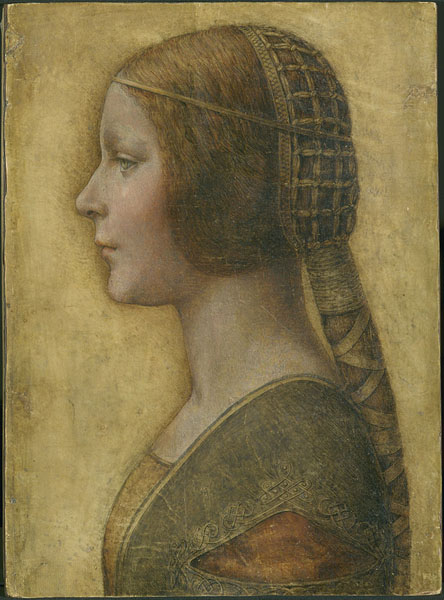The Portrait of a Young Fiancee has created quite a storm in the art world since its discovery. At first thought to be a piece of late 19th century German artistry with Renaissance influences, the sketch is now believed to actually be a long lost work of the Renaissance master Leonardo da Vinci.
Made of chalk, pen, ink, and wash tint on vellum, it has been attributed to the Renaissance time period after careful study and carbon dating. The forensic evidence provided indicates that the artist was left-handed, and innovative for his/her time, which are both characteristics of Leonardo da Vinci.
The portrait is that of a young female. Her hair is in a single braid that descends down her back, covered in an elaborate headdress which was typical of late 15th century Italian costume. In particular, it is considered a “marriage portrait.” The young bride is “thought” to be from the Sforza family, but there are no real indicators in the portrait to this notion. In the Renaissance, it was typical for the artist to include some sort of identifying factor towards the family tree. After extensive investigation, some historians believe the girl is Biana Sforza, who was married by Proxy in 1489 (to a man she had never met) at the young age of seven.
The painting does give us some clues about this girl. Her dress is indicative of her higher social status, as is the fact that she was painted at all. Her chest appears to slightly curve out, but lacks more definition, suggesting that she is quite young — perhaps in her early teens. It is unlikely that she is only seven since she wears the dress of a married woman, so perhaps this portrait was created closer to 1496, when she finally went to live with her husband. The muted colors are not very indicative, as they are part of Leonardo’s signature style in using natural, muted colors. Her solemn expression could be a clue to her lack of enthusiasm at her marriage, or simply symbolic of the need¬†to keep still for a long period of time in order for Leonardo to paint.
Since there is not much known about the portrait, much of what we know is based on the process of elimination. It could very well be a long-lost piece of the great Leonardo; however, it is also possible that this piece is an attempt at copying the great master.
You can learn more about this extraordinary portrait in NOVA’s Mystery of a Masterpiece.

